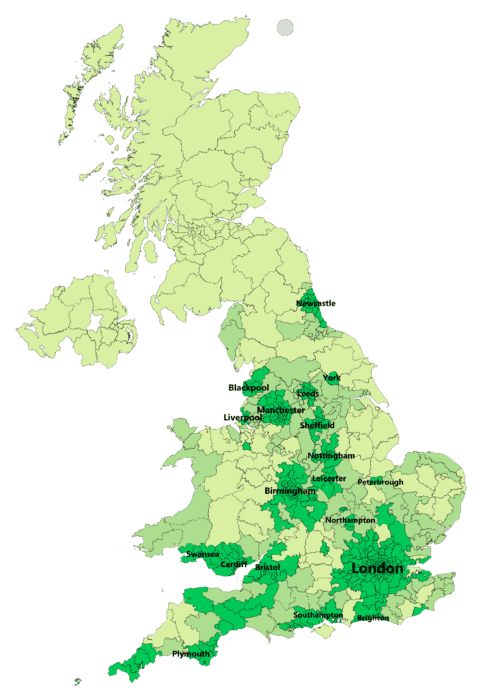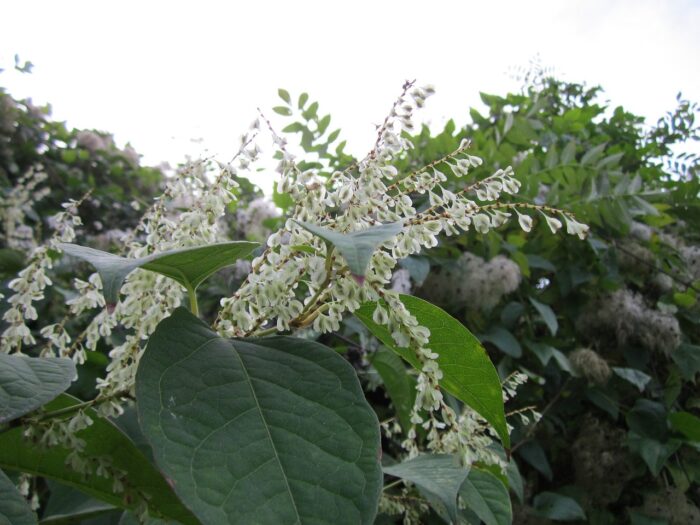Japanese Knotweed UK Map: Is there Japanese knotweed in my area?
Contents
Japanese Knotweed UK distribution map
Japanese knotweed is the most pernicious knotweed in the UK as the invasive perenial plant has spread to every corner of Britain. Japanese Knotweed continues to spread via its rihzome fragements across England and throughout Great Britain.
See how far it is from your area with our Japanese Knotweed UK distribution Map covering all the hotspots.
There is now one Japanese knotweed infestation for every 10 square kilometres in Britain. You can take a look at how badly the rest of the UK has been affected by checking the coloured map below – the darker the shade of region, the more Japanese knotweed has been discovered.

What is Japanese Knotweed?
Japanese knotweed is a contentious plant that can depreciate the value of a property and cause conflict between neighbours. The invasive plant is known for spreading quickly and for monopolising gardens. Japanese Knotweed damage can be severe as the plant can damage property foundations, flood defences and walls. Knotweed grows in large patches that can quickly push out any other competing plant life. Thankfully, Japanese knotweed is easy to identify, so homeowners can waste no time in getting a treatment plan in place to get rid of the plant.
Where is Japanese Knotweed from?
Japanese knotweed is from Eastern Asia. The plant originated from Japan, China, Korea and Taiwan. Japanese knotweed’s natural habitat is on the side of volcanoes but it has also been thriving in the UK’s climate since being originally introduced by the Victorians as an ornamental plant.
What does UK Japanese Knotweed look like?
In the UK, Japanese Knotweed flowers bloom between August and September when its heart/shovel shaped leaves can be up to 20cm long. In late summer, Japanese Knotweed’s creamy white flowers begin to appear in panicles and it’s bamboo like hollow stem’s zig zag growth pattern is particularly distinct. UK Japanese Knotweed grows to a height of 3m and does not produce seeds as there are only female Japanese Knotweed plants in the UK. From the Reynoutria Japonica species, Japanese Knotweed grows fastest in UK Spring when new shoots emerge as red/purple like spears. During Spring, the plants leaves are normally rolled up and dark green or red in colour. Japanese Knotweed is often wrongly identified as other common UK garden weeds as the plant shares many similar characteristics to common UK shrubs, weeds and plants such as Lilac, Dogwood, Red Bistors and Buckwheat.
How to recognise Japanese Knotweed in the UK
Often confused with many other common weeds, Japanese Knotweed is frequently wrongly identified throughout the UK. For a thorough, in-depth look at how to identify Japanese Knotweed, including many Japanese Knotweed pictures, check out our complete guide to Japanese Knotweed identification. Here’s a detailed list of the tell-tale signs for UK Japanese Knotweed.
- Japanese Knotweed red shoots emerge around Spring
- In late spring, Japanese Knotweed canes can reach up to 3 metres (10 feet) in height
- Shovel/Heart shaped 20cm long leaves unravel early Summer
- Knotweed’s hollow bamboo-like canes begin to turn brown in late summer
- Japanese Knotweed flowers form in small cream white clusters from September
- Throughout the year, Japanese Knotweed Rhizomes can be identified by their dark brown exterior and yellow/orange interior
- Starting in late Spring, Knotweed leaves grow in a zig-zag staggered pattern on the plants’ stem
- During Winter, UK Japanese Knotweed appears to die back as its leaves turn brown and drop off
- Throughout UK winter, Japanese Knotweed stems turn completely brown while the plant’s rhizome network is still thrives below the surface
Where is Japanese knotweed originally from?
Japanese knotweed is originally from Japan and is also native to China and Korea. The plant is one of many species of plants that have been discovered to be growing on the side of volcanoes. In its native land, Japanese knotweed can reproduce naturally and also benefits from a prodigious underground system of rhizomes. In its native environment, knotweed is kept in check by natural predators in the form of fungi and insects, not to mention other plants and an environment that can be much more hostile than the United Kingdom.
Who discovered Japanese knotweed?
The plant was originally discovered by Dutch naturalist Maarten Houttuyn in the 18th-Century, he named it Reynoutria japonica, a name which it still goes by today. Unfortunately, the records of this original discovery were lost for some time, so when more European botanists started exploring Japan some 150 years later, the plant was rediscovered and given a new name by a Bavarian botanist, Phillip von Siebold. Siebold and his partner Zuccarini, named the plant Polygonum cuspidatum. It wasn’t until the turn of the 20th century that a Japanese botanist by the name of Makino, discovered that Houttuyn and Siebold’s plant were one and the same.
Japanese knotweed weeds UK
Japanese knotweed – one of the UK’s most pernicious weeds – reproduces and spreads throughout Britain via knotweed, contaminated soil and rhizome fragments. Since 1850, knotweed has spread across Great Britain with areas of high concentration found in Bristol, Nottingham, Rotherham and Glasgow.
Who brought Japanese knotweed to the UK?
Philip von Siebold brought Japanese knotweed to the UK in 1850, unaware of the impact that it would go on to have on the environment. At the time, botany and the cultivation of plants was a popular interest of the upper classes. Botanist like Siebold would be able to fund their research trips by sending their discoveries back to nurseries on the European continent, where they would then be cultivated and sold onto commercial nurseries or botanical gardens around the world.
Where is japanese knotweed found in the UK?
Japanese Knotweed has been discovered across the UK. New Japanese Knotweed UK heat map data shows that the hardest-hit areas of knotweed continue to be in the north of England and the Midlands. The North West of England has the highest concentration of Knotweed in Britain. Bolton, Lancashire, UK is the worst affected area with 652 infestations within a 4km radius. London, England also suffers from high concentrations of knotweed as in many parts there are over 200 occurrences within 4km, many other japanese knotweed hot spots can also be found in Bristol, Rotherham, Nottingham and Glasgow. Most UK-Japanese knotweed is distributed across the North west, South West Wales and central london.
Why was Japanese knotweed imported to the UK?
Japanese knotweed was imported to the UK for commercial sale and botanical cultivation. Over the time that he spent in Japan, Siebold collected and recorded over 1,000 different plants, often choosing to plant them in the garden behind his research base on Dejima, an artificial island near Nagasaki. Periodically, Siebold would box up a number of samples and send them back to his home in the Netherlands. From their new home in Leiden, these plants would be carefully grown and then packaged up for botanical gardens in Belgium and Britain, with an unmarked box containing Japanese knotweed arriving at London’s Kew Gardens in 1850.
Kew Gardens often relied on these boxes of new plants to keep their own collections diverse and interesting for visitors. After discovering how quickly the plant could grow in Britain, the horticulturists there recognised Japanese knotweed as a plant that could be easily cultivated and sold on to budding gardeners.
Japanese Knotweed was introduced to the UK because German Botanist and traveller Phillipp Franz Von Siebold brought over the Knotweed to cultivate and sell as an ornament to the wealthy classes as Japanese Knotweed’s bloom and oddly shaped leaves were the height of fashion.
Soon the plant was being distributed to garden nurseries around the country and then shared in cuttings by enthusiastic gardeners. In addition to being intentionally spread by people, the plant also began to spread by its own means, populating river banks and finding new routes to the rest of the country along roads and newly built railway lines.
How did Japanese knotweed spread throughout the UK?
The strong, almost woody stems of the Japanese knotweed grew up to 20cm a day: a rate previously unheard of. At a time of intense industrialisation and construction, this hard-working plant proved to be extremely useful. Soon scores of these plants were lining the gardens, shoring up banks along prospective railway lines and being enthusiastically shared between gardeners.
Despite the alarming rate at which this new discovery grew the Victorians believed that they had it under control. Their confidence was derived from the fact that only one gender of the plant was imported. Gardeners and scientists applauded themselves with their ingenuity in gaining control over such a useful organism, but they hadn’t considered the possibility that this alien plant might have another way of reproducing itself.
Known in some horticulturist circles as ‘the largest female in Britain’; to this day, every single Japanese knotweed plant exists as a clone of the original female plant that was brought to Britain well over 100 years ago. The plant’s impressive dispersion across the country can be contributed to its construction on a cellular level. Fragments of the plants’ roots, known as rhizomes, are all capable of travelling far from their source and growing into entirely new plants by themselves.
Is there Japanese knotweed in my area?
Japanese knotweed has since been designated as an invasive plant by the UK government making, improper disposal or transporting of it a criminal offence. That hasn’t stopped it spreading further across the UK, with only settlements in the Northern most region of the countries remaining unaffected.
It’s difficult to pin down how far the plant has spread, as knotweed often remains dormant in root systems beneath the ground during colder months. An infestation discovered in the lead up to the London 2012 Olympics led to the government shelling out an estimated £70 million, whilst Swansea has been besieged for decades with the local council struggling against an ever-expanding 250 acres of knotweed.
Where does Japanese knotweed grow in UK?
Japanese knotweed now grows in almost every area of the UK. As shown on the Japanese Knotweed UK map above, Knotweed is found primarily in the suburban areas of major UK cities such as London, Manchester, Liverpool, Birmingham and Newcastle. There is also a lot of Japanese Knotweed in England as it is especially prominent in the South East in areas such as Cornwall.
Japanese Knotweed spread throughout the country for over a hundred years before being recognised as invasive by the government. By the time Japanese knotweed was identified as an invasive threat in 1981, it had already been spread by gardeners, dug up and transported by urban development projects and even used to stabilise soil on the sides of railway lines.
The plant is frequently found growing alongside public watercourses such as canals, as well as near railway lines, motorways and public footpaths. Japanese knotweed thrives in most conditions in the UK and is often found growing on land that has been abandoned or left unattended. For this reason, large infestations can often be discovered in overgrown back gardens, or on abandoned industrial sites.
How common is Japanese knotweed in the UK?
Japanese knotweed is a very common sight in the UK. Since the government has made the spread of Japanese knotweed a more pressing concern, efforts have been made to track where it has been growing throughout the country. Using these statistics, it’s been possible to recognise the areas of the country that have been most affected by Japanese knotweed. Bolton, Bristol, Conwy, Rotherham and Nottingham are areas in the UK that have been affected the most, however exact numbers are difficult to assess.
How to get rid of Japanese Knotweed in the UK?
To get rid of your Japanese Knotweed, you will need to chemically treat the plant over the course of 3 years as UK Japanese Knotweed needs to be sprayed and re-sprayed. This is done through a professional-grade glyphosate Japanese Knotweed treatment plan administered by a PCA-accredited firm that can offer a guarantee that will be trusted by mortgage lenders and any potential buyers. For small infestations, Japanese Knotweed UK removal can take two years, while larger plants can take three or more years to be fully eradicated. While professional treatment can be more expensive, it provides the best chance of removing the plant perminantly, which in the long term means you’ll have a smaller Japanese knotweed removal cost.
What does it cost to remove Japanese knotweed?
Costs for Japanese knotweed removal vary depending on the area that has been affected and the form of treatment that you opt for. In order to manually remove the rhizomes from beneath 4 square yards of the ground you would have to dig up 20 square yards. Take into account the removal of any paving or pipes and the costs could be up to £1,000 per visible square yard.
Another option is to attack the plant with an industrial-strength weedkiller. Although this option is undeniably cheaper it’s a long-term solution—the costs of around £2,000 to £5,000 are spread out over a number of years. These may seem like big investments but it’s better than simply ignoring your problem. Left unchallenged Japanese knotweed can spread like a virus across land and into buildings, leeching anywhere from 5-20% off the value of your home.
What do I do if I find Japanese knotweed?
If you find Japanese knotweed it’s important to ascertain where the plant has come from and to what extent the plant affects your property. You may want to consider contacting a Japanese knotweed specialist to make a positive identification before you move forward with talking to any neighbours who might also have the plant on their land. Ignoring the infestation is not advised, as the plant can quickly multiply, leading to a larger problem to deal with and potentially more costs, if you find that it’s not possible to claim compensation for the cost of treatment.
If you think you’ve found Japanese knotweed and would like some advice on what to do next, then you can contact us. As Japanese Knotweed Specialists, we can help identify your Japanese knotweed problem and hire a professional team to remove it, in some cases we can even recover your costs. If you think you’ve spotted Japanese knotweed on your land, or in your neighbour’s garden, then please send us an email to knotweed@cobleys.com or call us on 0151 242 9050.

